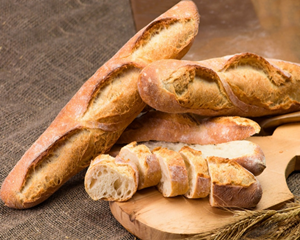The humble French baguette is currently the toast of the town.
这个看起来并不起眼的法国长棍面包,现在成为了广受欢迎的产品。
The crusty loaf was voted onto a prestigious UNESCO list, under the title "artisanal know-how and culture of baguette bread".
这种硬皮面包于日前被列入联合国教科文组织的非遗名录中,头衔为“法棍面包的手工技术和文化”。
And to this day, it remains a key part of French identity.
直到今天,它仍然是法国身份认同的重要部分。
Baguettes take their place on the "intangible cultural heritage list" alongside other important traditions,
和法棍面包一道被列入“非物质文化遗产名录”的其他重要传统还包括:
like truffle hunting in Italy and handmade Christmas tree decorations in the Czech Republic.
意大利寻找松露的艺术、捷克的圣诞树手工饰品技术等。
The exact origins of the lengthy loaf aren't known.
这种长面包的确切起源尚不清楚。

Some say the bread was ordered by Napoleon because it would be easier for soldiers to carry.
有人说是拿破仑定制的这种面包,因为士兵携带起来会比较方便。
That can't be proven, but the baguette as we know it today was only officially named in 1920.
这种说法尚无法得到证实,但是我们今天所知道的法棍面包,是在1920年才被正式命名的。
It was then that strict rules about what classed as a baguette were put in place -- standardised at 80cm long and 250g in weight.
也是在那个时候,法国出台了严格的法棍标准--长80厘米,重250克。
The baguette has struggled in recent times with hundreds of artisanal bakeries closing down each year.
由于每年都有数百家手工面包店倒闭,法棍面包最近举步维艰。
But UNESCO's decision has struck a chord with French society.
但联合国教科文组织最近的这一决定,引起了法国社会的共鸣。
President Macron captured the mood of the nation, posting this picture along with a simple message, "250 grams of magic and perfection in our daily lives."
马克龙总统就抓住了国民的情绪,他发布了这张照片,并附上了一条简单的文案:“区区250克,在我们日常生活中充满着魔力和完美。”











